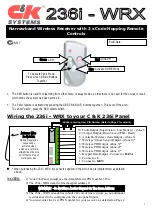
52
Playback of up to 192kHz, 24-bit sound formats
This receiver is capable of playing back 96kHz/24bit sound formats (such as DTS 96/24 and PCM 96kHz up to
24bit). Besides, when connected to an i.LINK-equipped component, playback of up to 192kHz, 24-bit sound
formats (such as DVD-A) is supported.
To Playback with the Best Sound Quality (all processing is done without down sampling).
For 192kHz format, choose STEREO mode and turn off sound functions. For DTS 96/24 5.1 format, connect
both center and surround left/right speakers, choose STANDARD mode (If you select 7.1 in LISTENING CH
SELECT, choose STANDARD SX mode.) and turn off all sound functions. For 96kHz 2ch format (either DTS or
PCM) choose STEREO mode and turn off sound functions.
Although you should turn off all sound functions, TONE CONTROL may still be used.
You can listen to DTS 96/24 soundtracks through this receiver if your DVD player has a DTS output feature, even
if it can't output 96kHz digital signals. For PCM 192/96kHz soundtracks, however, you won't be able to listen to
them with digital connections if your DVD player can't output 192/96kHz digital signals. Also, if you set
"DYNAMIC RANGE CONTROL" (see p.100) on, playback will be downsampled.
Check the manual that came with your DVD player to confirm what it can output and for more information on
these formats.
Listening Modes
The five listening mode types on the receiver are explained here. These can be turned on from the front panel or
from the RECEIVER MAIN screen on the remote control. To select listening modes see p.49-50
.
The kind of playback you can get in the threse listening modes depends on what kind of source (DVD, etc.) you
are using. The basic distinction is between 2 channel sources and multichannel sources. The playback available
to you with these modes will differ depending on the source, speaker configuration the LISTENING CH SELECT
setting. This is explained below.
Basically the ADVANCED CINEMA mode is for movie sources and the ADVANCED CONERT mode is for music
sources. The STANDARD, HOME THX and STEREO modes can be used with any source though the latter won't
offer surround sound. Try different settings with various soundtracks to see which you like.
You must choose one of the surround modes in order to get surround sound. Depending on your setup, in
STEREO mode only the front two speakers, and sometimes the subwoofer (if you have one), are used.
STEREO modes
When a source is played in this mode, it plays through just the front left and right speakers (and possibly your
subwoofer depending on your speaker settings). Dolby Digital and DTS multichannel sources are downmixed
to stereo.
STEREO
In STEREO mode the audio plays according to the surround setup settings and you can still use Acoustic
Calibration EQ, Digital NR, Midnight mode, Loudness mode and Tone Control functions.
DIRECT
In DIRECT mode, the audio passes through the shortest signal path possible to remain as close to the source
audio quality as possible.
Note: If you switch on Acoustic Calibration EQ, Digital NR, Midnight mode, Loudness mode or Tone Control
when DIRECT is selected, the receiver automatically switches to STEREO.
STANDARD modes
This mode is for pure decoding of Dolby Digital, Dolby Surround and DTS sources as well as surround matrix
decoding of 2 channel sources. It is good for enjoying regular movies/videos that have been recorded in Dolby
Digital, Dolby Surround and DTS. STANDARD EX/SX is also the basic mode for enjoying sources with surround
and surround back channels. For more detailed information see p.106-107. You will only be able to access the
second two modes if you have hooked up surround back speaker(s). For more detailed information see p.14, 28,
40-42. The display will show you what kind of source (Dolby Digital, DTS, etc.) is being played or which mode
has been selected.
Basic Operation
memo
















































